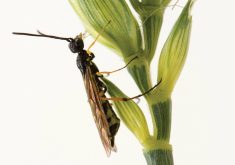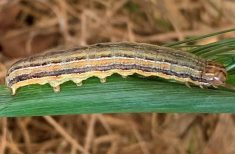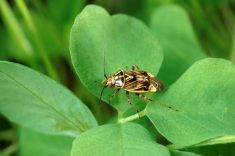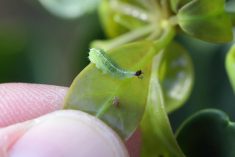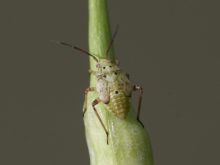Cereal Aphid Manager is a useful smartphone app for farmers looking to control one of the main pests in wheat, barley, oat and rye crops in the Prairies. The tool’s scientific developer, Tyler Wist, believes it’s time to hit refresh on the mobile app first released six years ago.
Cereal Aphid Manager helps farmers and crop advisors tackle aphid problems in fields by predicting what aphid populations will be in seven days and the best time to apply insecticide.
Read Also

Cancer agency reclassifies another herbicide ‘probably carcinogenic’
The WHO’s cancer research agency has now put atrazine, a herbicide well known to corn growers, in the same potential-hazard category where the agency put glyphosate.
The app from Agriculture and Agri-Food Canada is based on a model that treats a grain field as an entire ecosystem by considering many complex biological interactions — including the impact of beneficial insects that help limit aphid populations.
Wist, an AAFC entomologist based in Saskatoon, applied for research funds to update the app in April through the Saskatchewan Ministry of Agriculture’s funding call, where many grower groups that represent farmers participate in funding research.
According to Wist, the money is needed to help ensure Cereal Aphid Manager keeps up with newer technologies. The app, which came out in March 2018, can be used on Apple and Android platforms, but there have been numerous changes in these operating systems since then.
Wist says he knows several grower-funded research groups are interested in helping get the app back up to speed.
“This was built for an older version of Android, for example, so we’re at that point where we need to do a little bit of upgrading,” he says.
Wist hopes to improve Cereal Aphid Manager in several other areas too — including adding canary seed to the app’s list of crops.
He notes two primary cereal aphid pests on Prairie farms are also a problem in canary seed production. Wist and fellow AAFC research scientist Bill May have completed work on determining economic thresholds for controlling aphids in canary seed crops, which they’d like to see incorporated in an updated Cereal Aphid Manager app.
Wist also hopes to enhance an aspect of the app called the dynamic action threshold, which takes into account the pressure insect predators and parasitoids put on aphid populations.
In simple terms, an action threshold is that point where a pest problem is considered serious enough to warrant actions, like insecticide spraying, that can prevent the pest population from causing economic damage.
The dynamic action threshold in Cereal Aphid Manager factors in the number of different natural enemies of aphids that are present in a grain field and how many aphids they can eat or parasitize per day.
“If you’ve got enough predators and parasitoids in your field and they’re there early enough, they can stop an aphid infestation … and you might not have to get in there with your sprayer,” says Wist.
Wist notes there are new pictures and some recent research data on the voracity of aphid predators and parasitoids he’d like to add to the app to increase its effectiveness as a crop protection tool.
Prairie predators and parasitoids
Presenting at the CropConnect conference in Winnipeg in February, Wist shared photos, videos and information about some beneficial insect predators and parasitoids, not just in cereals but in other crops as well, that farmers could see this coming growing season.
READ MORE: Predators and parasitoids – your bug buddies in the field
This includes lady beetles, commonly referred to as lady bugs. This voracious insect will feast on aphids at both the larval and adult stages, making it “a really great predator” in Wist’s eyes.
Wist says there are numerous species of beneficial parasitic wasps in Prairie crop production. These kill pests by injecting them with eggs that produce larvae, which consume their insect hosts from the inside out.

While his research shows only one parasitic wasp species, Aphidius avenaphis, is a significant natural enemy of cereal aphids, Wist notes it can have a sizable impact.
A single female A. avenaphis wasp, for example, can kill up to 25 to 30 English grain aphids in one day, leaving “aphid mummies” with their offspring inside.
Smartphone tools such as Cereal Aphid Manager enable farmers to factor in insect predators and parasitoids in their spray decisions, but as Wist points out, there are other steps they can take to protect beneficial insects.
One is to provide shelterbelts and other areas where beneficial insects can flourish and also take refuge during the colder months. Undisturbed leaf litter at the base of a tree, for example, is the perfect home for lady beetles nestling in for the winter.
Wist says beneficial parasitic wasps feed on nectar, so seeding some areas within or around fields with flowering plant species gives them a place to eat and build up energy to attack aphids and other pests.
Some lady beetle species feed on pollen, he adds, so having flowering spaces around the farm will help sustain beetle populations.
For scouting tips and more information on practices that can help preserve important pest predators and parasitoids, Wist recommends farmers and crop advisors check out the Field Heroes website.
Wist maintains the Field Heroes campaign, launched by the Western Grains Research Foundation in 2017, has contributed a lot to increased farmer awareness of beneficial insects in cropping systems.

How Cereal Aphid Manager works
The Cereal Aphid Manager app, which can be downloaded from the Apple Store or Google Play, is a scouting tool to help grain producers determine whether an aphid population will grow large enough to pose a significant threat to crop production. Users can also access a French-language version at the touch of a button.
Users walk a certain path through a field, which is recommended by the app. It includes a minimum of five stops, at which users count the number of aphid and beneficial insects. To help them identify insects, Cereal Aphid Manager also includes a photo guide.
After completing the recommended path, the app will provide a prediction for whether to spray or not spray, or if and when the user should sample the field again. The recommendation, along with the survey date, is stored on the user’s device to keep track of a field’s aphid population over the course of a growing season.
According to AAFC, it’s important to note winds can spread cereal aphids from the northern United States onto farms in the Canadian Prairies — something Cereal Aphid Manager cannot predict. Because of this, farmers and crop advisors are urged to check their fields regularly during the growing season, regardless of what the app recommends.





